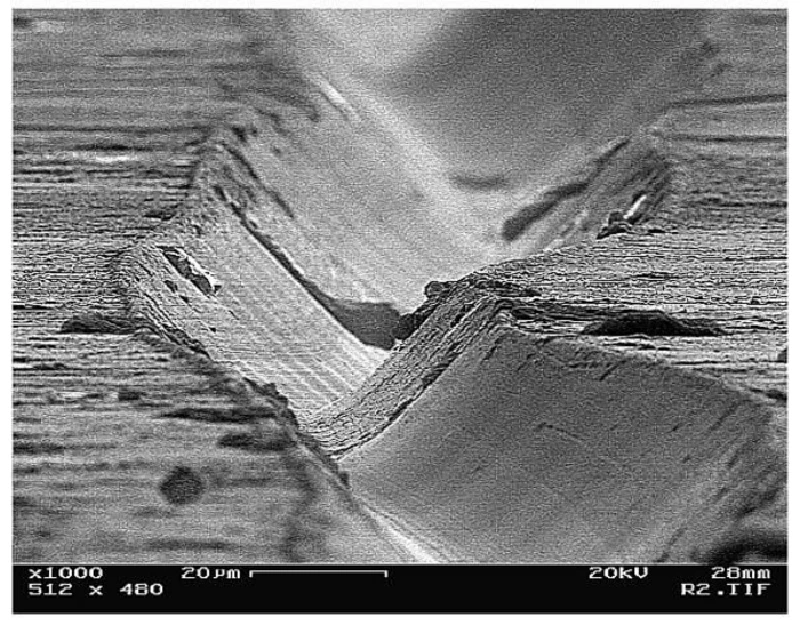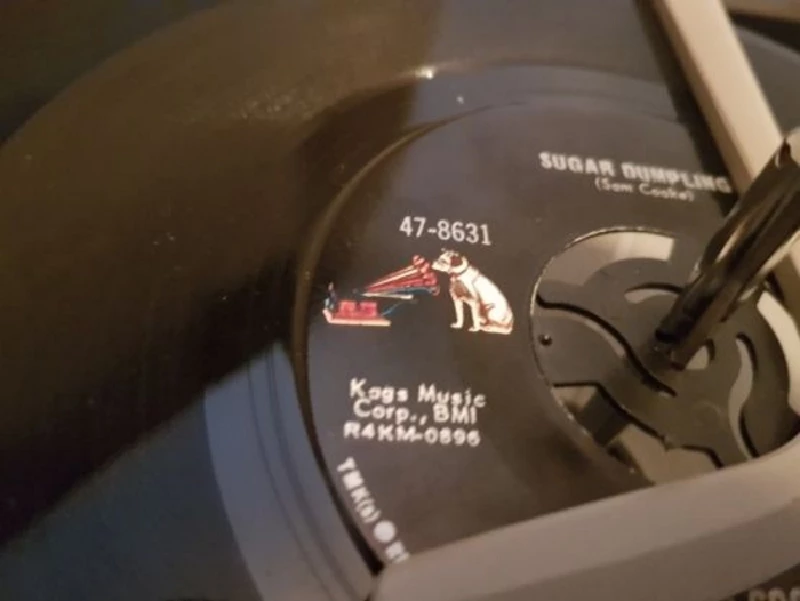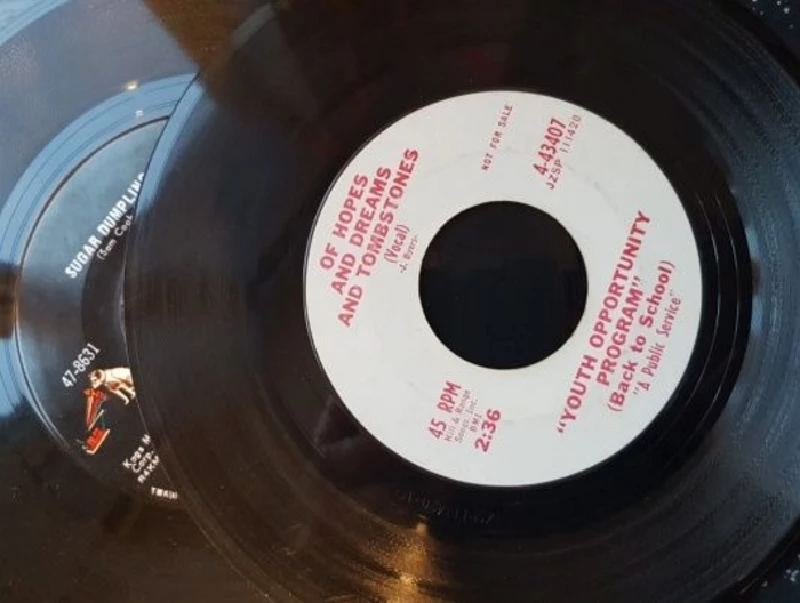Miscellaneous - Planet Vinyl A Natural History Part 1
by Dave Goodwin
published: 30 / 6 / 2017

intro
Dave Goodwin's Vinyl Stories takes a new turn this month with the first part of a very personal history of the vinyl record - and then some
Okau, you clever people. Study picture 1 and tell me what it is. To me, when I first looked at it, it looked like a valley on the surface of the moon or somewhere really dry like the Sahara. Right? Wrong. When I explained it to my wife she called me a nerd and told me to start this article with a big NERD ALERT! 'Bah!', said I. It's like Marmite. You either love it or hate it. But, as it happens the sound of vinyl is the choice of many music fans. And that is exactly what the picture is. That is the sound of the record. It's the groove, by golly. Ah, so you knew that, eh? OK, then: they are both made of vinyl, but what's the difference between a mono recording and a stereo one? Later, my eager beaver friends, we’ll come back to that. As you are probably aware I have been buying records all my life. I've lost and sold some and ended up replacing the ones I've lost. I moved on to the CD, of which I have a huge collection, mainly because vinyl was considered dead by the late 1980s and all music from that point went on to CD. Then the sound of vinyl slowly regained popularity and now once again I find myself going on regular forays to the local record store. I can sit for hours sometimes just looking at the stuff I've bought over the years, from my Northern Soul recordings that came out on small obscure local record labels to pressings put out by huge corporations such as Columbia and RCA. I still analyse the print on them to find out where they came from. I have chosen one of my records at random to use as a talking point: it is by Jimmy Frazer, the boxer, and is called ‘Of Hopes and Dreams and Tombstones’. It’s actually on Columbia but this is a nice red and white demo version credited to The Youth Opportunities Programme. But where did they come from? I mean the records themselves: how did they come to life in the first place? I heard stories, while collecting US originals, of groups in the old days saving enough money to get a record ‘cut' so they could produce maybe 500 to sell and make money from. Why do certain records command such high prices nowadays? Just that one question has so many answers that it's a story in itself which we will try and answer later but for now to understand where the wonderful black wax came from we need to understand its origins. So to coincide with Record Store day I have decided to take you on a journey back to the beginning. We have to go way back to 1877, just 15 years after the more clever people in Britain started kicking a football around, when Thomas Edison and his assistants attached a needle to the diaphragm of a telephone receiver with the idea that the needle could be used to etch an impression of sound onto quickly moving paper, thus creating a recording. It worked, but Edison can't take all the credit, because around the same time a French inventor named Charles Cros wrote of a machine called the paleophone that could record sounds - but he never patented it. Edison got scientific with it and came to understand that sound is the vibration of waves across a medium, such as air. The clever chap developed a way to imprint or record the waves so that they could be turned back into sound using a second needle, and as if by magic the phonograph was born. A clever device, it had a brass cylinder wrapped in tinfoil, which rotated and moved lengthwise when turned by a hand crank. On one side was a diaphragm or very thin membrane, connected to a needle so that when sound waves were forced into the receiving end, it caused the membrane to vibrate, rather like a kazoo, and the needle to etch a groove into the foil as the cylinder was being turned by the crank. By sticking a second needle and an amplifier on the other side when the cylinder was set to the beginning, the original sound was reproduced in the grooves as the vibrations were amplified. You might have thought that to introduce his invention to the world Edison would have had the London Philharmonic playing away but instead he opted for a simpler voice recording by shouting the words to "Mary had a little lamb" into a mouthpiece, causing the sound waves to vibrate a needle and etch the nursery rhyme into tinfoil for playback. Marvellous! The phonograph was of course a breakthrough, as it was the first of its kind that had the ability not only to record sound, but to play it back. Edison considered applying the technology to toys such as talking dolls and music boxes and also thought it might be useful in offices for dictation, for families to record their history or for teachers to record lessons. Because the tinfoil on which the recordings were made did not last, interest in the machine suffered, so Edison put it aside to pursue work on other inventions - only to find that when he resumed work on the phonograph nearly 10 years later, another cad, sorry, inventor had moved it one step closer to the record player we know today. In 1887, a German inventor in the USA named Emile Berliner improved on (or stole) Edison's design but instead of a cylinder with the sound etched in tinfoil or wax, he developed a device that rotated a hard rubber (later, shellac) disc on a flat plate by the turn of a crank. Shellac? What’s that, I hear you ask. Well, Shellac is a resin secreted by the female lac bug on trees in the forests of Asia. It’s processed and sold as dry flakes which are dissolved in ethanol to make liquid shellac which is then used as a tough natural primer, sanding sealant, tannin-blocker, odour-blocker, stain, and high-gloss varnish. The important bit to know here is that phonograph and 78rpm gramophone records were made of it until they were replaced by vinyl long-playing records from the 1950s onwards. Berliner's machine, the gramophone, could only play back the discs, not record them. So Berliner started the Gramophone Company, which manufactured not only the machines, but the records too. What was lost in the ability to both record and play back sound in one machine resulted in a new system whereby mass-produced recordings could be played and shared. Berliner merged his company with that of another clever bod, Eldridge Johnson, and in 1901 it became the Victor Talking Machine Company. It manufactured and advertised both gramophones and records. Johnson changed the design of the gramophone, which until that time had a large horn to amplify the sound. You know the sort - the square box with the trumpet sticking out the top. This design wasn't very welcome in the home so in 1906 he made the Victrola in which he tilted the horn down and put the whole thing in a cabinet. Meanwhile his company which was also manufacturing discs recorded famous opera singers and musicians, giving the public access to music on a different scale to what had ever gone before. After this point in time, the design of the gramophone and the recording process were continuously changing, but the main ingredients (a needle in a groove) remained the same. By the mid-20th century, most households had what was then commonly known as a record player and more recently called a turntable. Its mass popularity lasted until about the mid-1980s when cassette tape recordings overtook records and then music entered the digital age and the Compact Disc was born. My own experience of the playback machines dates back to the 1970s when my dad had a massive radiogram in the front room of our council house in Nottingham. It was huge. Made of wood with built-in speakers either side and a lift-up top in the middle which hid the turntable and housing with enough room to store a few albums or so. On the front of it was a long radio dial with set points on it with things like Luxembourg, World, Radio One, London and Munich, and all sorts of faraway places on it. Dad told me once that there were other channels not actually listed on the front and some even had girls names like Caroline and such but I could never find them. He later changed that machine for another Radiogram but a smaller version of it. Shortly after this I got my first record player which was an Amstrad double-cassette tower system which I kept even when I left home at 16 and got my own place. A while later I invested in my first separates. I had all Pioneer gear including the turntable and an amp which I still have to this day even after all the house moves and one of our dogs pissing into it one weekend whilst we were moving stuff around. I have also found myself going full circle with record players. After I bought an old Dansette Bermuda I decided to refurbish it knowing nothing of what I was doing. So having studied a while before I took it to bits and got it working again to the extent that now it looks and sounds brand new. From this I have since bought a very sought after Dansette 'Auto-mix' which I am about to start a full refurbishment on. They look the biz. For those still with me, we're on our way to finding out what exactly goes on during a record player's playback, but first, we need to understand the basics of how a vinyl record is created. Enter my choice of record for this piece, my copy of Jimmy Frazer's 'Of Hopes and Dreams and Tombstones' on Columbia. To make things easier we are going to call him Jimmy. The success of the gramophone was dependent on one thing - the ability to mass produce records like Jimmy’s. First a master recording is made, usually in a studio where engineers perfect the recorded sound. Nerd Alert! Then an object called a lacquer is placed on a record-cutting machine, and as it rotates, electric signals from the master recording travel to a cutting head, which holds a stylus, or needle. The needle etches a groove in the lacquer that spirals to the centre of our record. The imprinted lacquer is then sent to a production company where the lacquer is coated in a metal, such as silver or nickel, to produce a metal master. When the master is separated from the lacquer, the resulting disc has ridges instead of grooves. The metal master is then used to create a metal record, also called the mother, which is then used to form the stamper. Stampers are just negative versions of the original recording that will be used to make the actual vinyl records. Next, the stamper is placed in a hydraulic press, and vinyl is sandwiched in between. Steam from the press softens the disc as the stamper pushes an impression of the master recording onto it. Finally, the disc is stiffened using cool water and it's time to get the birthday cards out because Jimmy has just sprung to life. Once our Jimmy is ready to be played, he will need a proper machine to bring his sounds to life. And we can't send him out into the wild world naked. He needs a label with a name on it and he needs to be put on a special bag. In the next edition we will take you on a journey of Jimmy's life to how he's ended up in my box, we'll give you a quick rundown of the things that he has been played on, and try to answer the question: why did he cost as much as he did when I bought him and why does he cost as much as he does now?
Picture Gallery:-


most viewed articles
current edition
Carl Ewens - David Bowie 1964 to 1982 On Track: Every Album, Every SongSimian Life - Interview
the black watch - Interview
John McKay - Interview
Editorial - July 2025
Billie Eilish - O2 Arena, London, 10/7/2025
Armory Show - Interview with Richard Jobson
Hothouse Flowers - Photoscapes
Bathers - Photoscapes 2
Cleo Laine - 1927-2025
previous editions
Trudie Myerscough-Harris - InterviewPixies - Ten Songs That Made Me Love...
Boomtown Rats - Ten Songs That Made Me Love....
Fall - Hex Enduction Hour
Heavenly - P.U.N.K. Girl EP
Sam Brown - Interview Part 2
Place to Bury Strangers - Interview
Miscellaneous - Charity Appeal
Doris Brendel - Interview
Madness - One Step Beyond
most viewed reviews
current edition
Sick Man of Europe - The Sick Man of EuropeAmy Macdonald - Is This What You've Been Waiting For?
Phew, Erika Kobayashi,, Dieter Moebius - Radium Girls
Alice Cooper - The Revenge of Alice Cooper
Lapsley - I'm a Hurricane, I'm a Woman In Love
Davey Woodward - Mumbo in the Jumbo
Philip Jeays - Victoria
Blueboy - 2
Lucy Spraggan - Other Sides of the Moon
Cynthia Erivo - I Forgive You
Pennyblackmusic Regular Contributors
Adrian Janes
Amanda J. Window
Andrew Twambley
Anthony Dhanendran
Benjamin Howarth
Cila Warncke
Daniel Cressey
Darren Aston
Dastardly
Dave Goodwin
Denzil Watson
Dominic B. Simpson
Eoghan Lyng
Fiona Hutchings
Harry Sherriff
Helen Tipping
Jamie Rowland
John Clarkson
Julie Cruickshank
Kimberly Bright
Lisa Torem
Maarten Schiethart